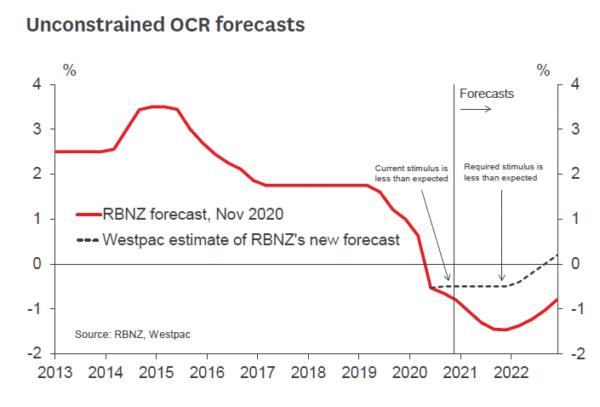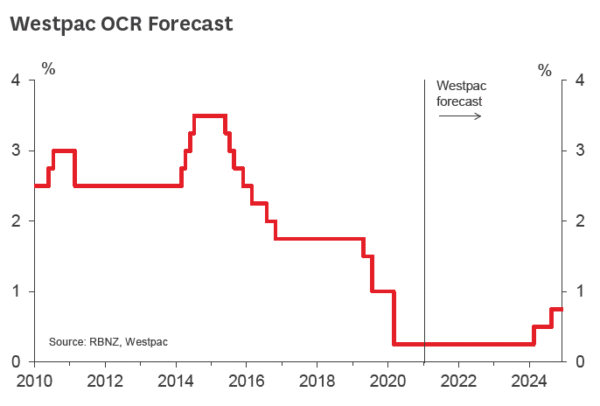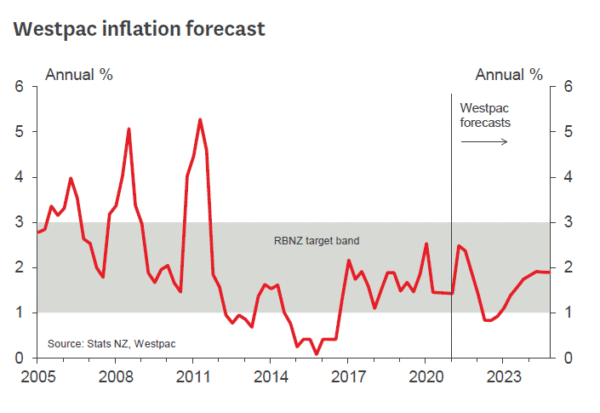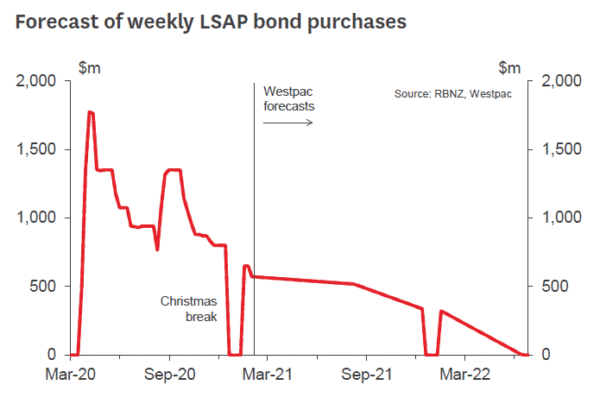- We expect the RBNZ will leave its monetary policy settings unchanged at next week’s MPS.
- Compared to previous expectations, less stimulus has been delivered but less is needed.
- In a case of two wrongs make a right, the RBNZ will conclude that current settings are about right.
- Inflation will spike to 2.5% by June, but will drop back to 0.8% by June 2022.
- We expect OCR hikes will begin only in early-2024.
- We expect that the LSAP will be tapered to about $70bn at the August MPS.
At next week’s Monetary Policy Statement, we expect that the RBNZ’s commentary will strike a more constructive note on the economy. Despite that, we expect that the RBNZ will leave its monetary policy settings unchanged. True, the economy has proved resilient. But the RBNZ’s stimulus measures have been less effective than anticipated, and the medium term inflation outlook is still very low. So we expect the RBNZ will keep the OCR at 0.25%, the Large Scale Asset Purchase programme (LSAP) cap will remain at $100bn for now, and the Funding for Lending Programme (FLP) will remain in place.
We expect the RBNZ’s key message will be that it intends to keep monetary policy very stimulatory for an extended period, even if inflation pops higher in the near term. However, the RBNZ might talk less about looming downside risks, and will probably not actively promote the possibility of further OCR cuts, as it did over most of last year.
Less stimulus is needed…
The RBNZ will acknowledge that there is now much less need for monetary stimulus than it thought back in November. Relative to the RBNZ’s November expectations, GDP has proved stronger, inflation higher, unemployment lower, and export commodity prices better. House prices are shooting through the roof when the RBNZ expected the market to slow. And inflation expectations have risen. There are just two partial offsets to this tide of upside developments – the Government has reigned in its planned fiscal stimulus and the exchange rate is higher than the RBNZ anticipated.
Given all of this, we expect that the RBNZ will lift its “unconstrained OCR forecast” substantially. Back in November, the unconstrained OCR forecast indicated that stimulus equivalent to an OCR of -1.5% was required. This time, we expect that the unconstrained OCR forecast will be about -0.5%, which is a huge step up. 
…but less stimulus is being produced, too.
However, the RBNZ will also point out that it has had less luck producing monetary stimulus than it hoped. According to our estimates, the low OCR, LSAP, and FLP all together are generating monetary stimulus equivalent to an OCR of about -0.5%.1
In a case of “two wrongs can make a right”, that means that current monetary policy settings are producing about the right amount of monetary policy stimulus, so nothing needs to change (assuming that the RBNZ arrives at the same conclusions as we have).
Longer term outlook.
Markets are flirting with the idea of the RBNZ lifting the OCR, but we expect no hike until early-2024.
The nub of the matter is inflation. We expect inflation will spike to 2.5% by June this year, mainly due to supply-side constraints, shipping delays, and rising commodity prices. However, such disruptions to supply will be temporary. We expect inflation will fall to 0.8% by June 2022 as disruptions to global supply chains ease and commodity prices stabilise or fall. We also expect a big lift in the exchange rate, to 78 cents against the USD, which will further constrain inflation. Finally, the economy is still grappling with the large hole in demand resulting from the lack of international tourism. Consequently, while we are seeing a pick-up in sectors like housing and construction, the economy as a whole is still operating with significant spare capacity. The resulting hole in demand will constrain domestically-generated inflation and keep employment below the maximum sustainable level. We don’t expect that the economy will be operating at full capacity until early-2022.
If we are right, and inflation does drop below 1%, the RBNZ will have little cause to lift the OCR
That said, later this year we expect the vaccine rollout to broaden and the timeline for reopening the borders to become clearer. Meanwhile, we expect that house prices will continue to rise much faster than RBNZ forecasts – and the political heat associated with that to intensify. Under these conditions, the RBNZ will see fit to reduce some of the unconventional monetary stimulus that it has in place.
The Funding for Lending Programme would not be easy to reverse, but later this year the RBNZ may make it clear that the programme won’t be renewed beyond the eighteen months to two years already allowed. This would diminish its impact on mortgage rates.
At the August MPS, we expect the RBNZ to formally reduce the LSAP cap to $70bn by June 2022. This will be partly in response to the outperforming economy, and partly due to a further reduction in the Government’s plan to issue bonds that we expect will be announced in May. We now expect bond issuance of $20bn in the year to June 2022, compared to the Debt Management Office’s current plan to issue $30bn, because the Government’s borrowing needs are so much smaller than previously thought.
Forecast of weekly LSAP bond purchases
Hoping, probably in vain.
Our last comment concerns the details of the LSAP. We are uncertain about how the RBNZ will describe its LSAP plans at next week’s MPS.
Previously, the Monetary Policy Committee instructed staff to purchase “up to $100bn” of bonds by June 2022, with the aim of keeping interest rates low across the curve. But in early 2021 the RBNZ sharply reduced the rate at which it purchases bonds, such that it is now on track to purchase a total of only $85bn by June 2022. Interest rates on long-term Government bond rates rose sharply, but there was no adjustment to the pace of bond buying to correct this.
Maybe we are barking up the wrong tree, but it seems a lot like the RBNZ has decided to slow the pace of bond purchases and allow long-term interest rates to rise, even though no such policy decision has been announced.
Our central scenario is that next week the RBNZ will maintain the status quo on the LSAP. But there is a possibility that it will provide some clarity on why it has slowed the bond purchases, along with some guidance on the pace of LSAP purchases going forward. This could take the form of a change in the LSAP cap or some other acknowledgement that the LSAP is already proceeding more slowly than previously planned. We certainly think something along these lines would be an improvement in the transparency of the LSAP.















